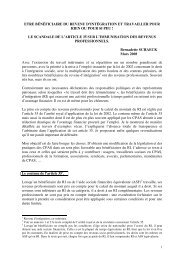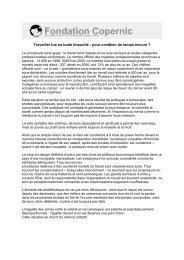Awra Amba RJ 300612 EN - Contacter un comité local d'Attac
Awra Amba RJ 300612 EN - Contacter un comité local d'Attac
Awra Amba RJ 300612 EN - Contacter un comité local d'Attac
You also want an ePaper? Increase the reach of your titles
YUMPU automatically turns print PDFs into web optimized ePapers that Google loves.
<strong>Awra</strong> <strong>Amba</strong>, a current experiment of utopian socialism<br />
construction site. Beams, rafters and centre poles are hewn or cut from trees by the men. Branches of<br />
trees are collected and cut to desired lengths for wattles as the work progresses. Both men and<br />
women carry water for making the mixture of mud and manure, which is daubed on the wattles by<br />
both also (At05/38).<br />
Picture 12: Village houses; Stove and furniture specific to the comm<strong>un</strong>ity.<br />
Household furniture and fixtures include a bed with mosquito net, chairs made of frames of boughs<br />
of trees crossed with strips of leather, made at home. Most houses have a leather bench built into the<br />
wall for use in sitting and sleeping (At05/37; Ya08/89). They are equipped with a stove and similar<br />
furniture in all houses (see Picture 12), and often with a private weaving machine. The stove is a<br />
closed model specific to the village, designed by Zumra in 1979. It is raised off the gro<strong>un</strong>d to prevent<br />
yo<strong>un</strong>g children being burnt accidentally and has a chimney, which evacuates the smoke (this is not<br />
always the case in Ethiopia). The chimney has a bend in it, on which water can be boiled, and which<br />
also enables it to be cleaned. Energy consumption for cooking is half as high as elsewhere according<br />
to the German cooperation (GTZ). Each house is also equipped with a kitchen dresser made of wood<br />
and mud (Mamo, 2006; Jo10b/8).<br />
Houses and furniture are built from the same material as every African village has: mud. The<br />
difference is that they are built attractively, while bearing energy saving in mind, and also the need<br />
for furniture which can be made of the same mud, not limiting the design to just the basic roof and<br />
walls (Bat-Gil, 2009).<br />
Each household has a Turkish toilet on a cesspool. These toilets are grouped together, and are located<br />
50-100 meters outside the village (Jo10b/8). The village has some rubbish containers, which is most<br />
<strong>un</strong>usual in Ethiopia, in which the rubbish is burnt outside the village. Unlike the neighbouring<br />
villages, the houses and the village are very clean, which limits the infectious diseases like malaria<br />
(Ya08/89). The maintenance is done by all inhabitants of the village, <strong>un</strong>der the control of the<br />
sanitation committee of the cooperative (Crespo, 2012).<br />
Water is available at four taps; it is not clear if it is suitable for drinking or not (Crespo, 2011; 2012)<br />
(Question 27 in Annex). It is free at the old manual pump, whose well has been initially dug by the<br />
comm<strong>un</strong>ity and then deepened with the help of Finland (<strong>Awra</strong>amba, nd; Yi07/44), and has to be paid<br />
for at the taps installed by the State and connected to a diesel pump (Jo10b/9). The comm<strong>un</strong>ity had in<br />
January 2011 the project, <strong>un</strong>completed in 2012, to install a system for sewage disposal (Crespo,<br />
2011; 2012).<br />
The village has electricity. The grain mill operates partly on electricity and each house of the village<br />
has a light bulb to light; each family paid in 2011 1 birr the corresponding annual consumption, and<br />
more if it thought to have more consumed (Crespo, 2011); in 2012, each household is equipped with<br />
56 / 85

















